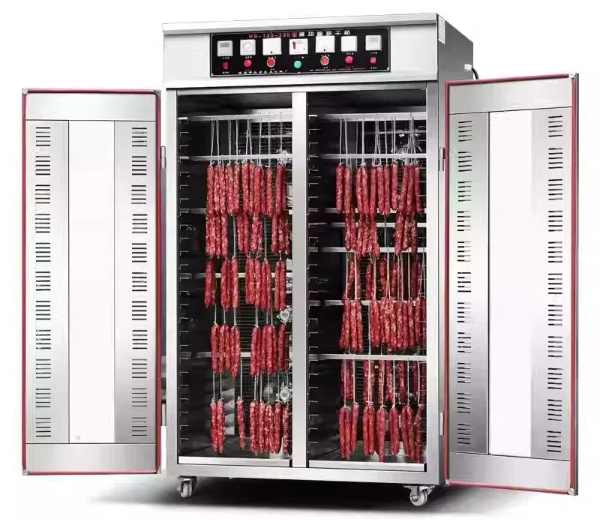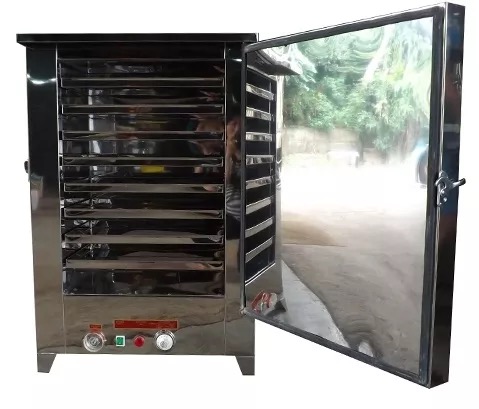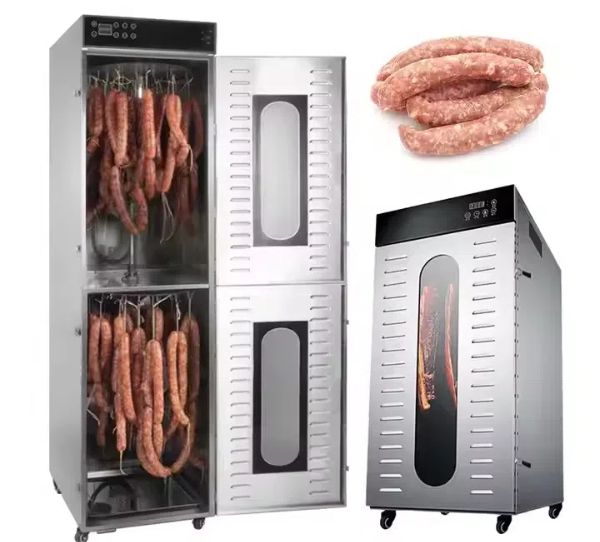
Content Menu
● Understanding Hang Type Drying Machines
>> Key Features of Hang Type Drying Machines
● Advantages of Hang Type Drying Machines
>> Enhanced Product Quality
>> Increased Efficiency
>> Energy Savings
>> Versatility
>> Automated Operation
>> Durability and Hygiene
● Applications of Hang Type Drying Machines
>> Noodle and Pasta Drying
>> Sausage Drying
>> Fish Drying
>> Meat Drying
>> Seafood Drying
● How Hang Type Drying Machines Work
● Factors Influencing Drying Efficiency
>> Material Properties
>> Drying Method
>> Equipment and Design
>> Control Systems
● Comparing Different Drying Technologies
● Integrating Hang Type Drying Machines into Your Production Line
● Best Practices for Operating Hang Type Drying Machines
● The Future of Food Drying Technology
● Conclusion
● FAQ
>> 1. What types of food products are suitable for hang-type drying machines?
>> 2. How energy-efficient are hang-type drying machines compared to traditional drying methods?
>> 3. What key factors impact the drying efficiency of hang-type drying machines?
>> 4. How can I seamlessly integrate a hang-type drying machine into my current production line?
>> 5. What are the essential best practices for operating hang-type drying machines effectively?
● Citations:
In the dynamic landscape of food processing, drying stands as a cornerstone technique, integral for preservation, quality enhancement, and significant value addition. Our food drying machine manufacturing facility in China specializes in offering OEM services to a diverse clientele including international brands, wholesalers, and manufacturers. Our hang-type drying machines are meticulously engineered to ensure optimal performance, unparalleled energy efficiency, and versatility. This comprehensive article delves into the intricate features, diverse applications, and myriad advantages of hang-type drying machines, showcasing their potential to revolutionize your food processing operations.

Understanding Hang Type Drying Machines
Hang-type drying machines are specifically designed for processing products that require suspension during the drying phase. This includes items such as noodles, spaghetti, sausages, and various types of fish. These machines operate by creating a carefully controlled environment in which moisture is gradually and evenly removed from food items, substantially extending their shelf life while scrupulously preserving their essential qualities and nutrients.
Key Features of Hang Type Drying Machines
- Food Grade Materials: Constructed with high-quality, food-grade stainless steel 304 for all hangers and the main machine body, ensuring compliance with stringent hygiene standards.
- Capacity Options: Our machines are available in a wide range of capacities, spanning from smaller 100kg units suitable for artisanal production to large-scale 10-ton units designed for industrial processing.
- Integrated or Separate Design: Flexibility is key. We offer two distinct design options for the dryer and chamber: an integrated design for compact spaces or a separate design to allow for greater customization of the drying process.
- Energy Efficiency: Cutting-edge heat pump technology allows for energy savings of up to 75% when compared to traditional drying methods, significantly reducing operational costs.
- Adjustable Temperature: Fine-tune the drying process with a broad temperature adjustment range from 18-80℃, allowing for precise control over moisture removal.
- Multiple Functions: Versatility is at the forefront. Our machines offer hot drying, cold drying, and dehumidification options to cater to a wide array of food products and drying requirements.
- Heat Pump Technology: Choose between open-loop, closed-loop, or a combined open and closed-loop heat pump dryer configurations for optimal energy efficiency and performance.
- Intelligent Digital Control: User-friendly operation is guaranteed with our intelligent digital control systems. These intuitive controls enable effortless programming, monitoring, and adjustment of the drying process.
- Mobility: Designed with robust pulleys for easy relocation within your facility, our machines offer unparalleled flexibility and convenience.
Advantages of Hang Type Drying Machines
Enhanced Product Quality
Hang-type drying machines excel in ensuring uniform drying, a crucial factor for maintaining the desirable texture, authentic flavor, and essential nutritional value of food products. The precisely controlled environment diligently prevents overheating and guarantees that moisture is extracted evenly, resulting in consistently high-quality products.
Increased Efficiency
Our machines are meticulously designed to dry substantial quantities of products simultaneously, significantly reducing the time and energy needed for effective drying. This efficiency directly translates into higher production capacity, streamlined operations, and substantially lower operational costs.
Energy Savings
A defining feature of hang-type drying machines is their utilization of advanced heat pump technology, which is demonstrably more energy-efficient than legacy drying methods. By delivering savings of up to 75% on electricity consumption, these machines offer a substantial reduction in your overall energy expenditure.

Versatility
Hang-type drying machines are highly versatile and can efficiently process a wide range of food products. This includes, but is not limited to, noodles, pasta variations, sausages, an assortment of fish, and more. In addition, they are capable of executing diverse drying processes, such as hot drying, cold drying, and specialized dehumidification.
Automated Operation
Equipped with state-of-the-art control systems, hang-type drying machines provide automated operation, markedly reducing the need for manual intervention and ensuring consistent, repeatable results. This automation leads to fewer errors and more streamlined production.
Durability and Hygiene
Constructed with premium stainless steel, these machines are not only exceptionally durable but also easy to clean and maintain, while strictly adhering to all relevant food safety standards. The hygienic design actively prevents contamination, safeguarding the integrity and safety of the food products.
Applications of Hang Type Drying Machines
Noodle and Pasta Drying
Hang-type drying machines are ideally suited for the efficient drying of noodles and pasta products. Their unique design ensures that these delicate items maintain their intended shape and texture throughout the drying process. The precisely controlled environment diligently prevents cracking and ensures uniform drying, resulting in superior product quality.
Sausage Drying
These specialized machines are ideally suited for the controlled drying of sausages. They work to meticulously preserve their distinct flavor profiles and substantially extend their shelf life. The efficient hanging method facilitates even drying and prevents sausages from sticking together, ensuring each product meets quality standards.
Fish Drying
Hang-type drying machines are perfectly suited for drying various types of fish. They work to effectively maintain their crucial nutritional value and prevent spoilage. The meticulously controlled temperature and humidity levels guarantee optimal drying conditions, resulting in high-quality, safe-to-consume dried fish products.
Meat Drying
Our innovative machines can be employed for drying a diverse range of meat products, including popular items like jerky and biltong. They meticulously ensure that these products are rendered safe for consumption and exhibit an extended shelf life, meeting the highest standards for both quality and safety.
Seafood Drying
Hang-type drying machines are also effectively used for drying an array of seafood items. These machines are specifically designed to maintain the quality and prevent bacterial growth, guaranteeing a safe and high-quality final product.
How Hang Type Drying Machines Work
The fundamental principle guiding the operation of hang-type drying machines centers on the consistent circulation of precisely controlled hot air around the food products. This meticulous process encourages moisture to evaporate from the food items, which is subsequently removed from the machine. The primary steps include:
1. Loading: Food products are carefully and evenly hung on the hangers inside the specialized drying chamber.
2. Heating: The advanced heat pump system efficiently heats the air to the specific, pre-determined temperature set by the operator.
3. Circulation: The heated air is then uniformly circulated throughout the entire chamber, meticulously ensuring consistent drying across all products.
4. Moisture Removal: The moisture that evaporates during the drying process is continuously removed from the chamber. This crucial step carefully maintains the desired humidity levels to optimize the drying environment.
5. Cooling (Optional): Select models feature an optional cooling function. This serves to gradually reduce the temperature of the dried products before their removal, enhancing their texture and overall quality.
6. Unloading: Upon the precise completion of the drying cycle, the now-dried products are carefully removed from the hangers, ready for packaging or further processing.
Factors Influencing Drying Efficiency
Several critical factors can significantly influence the drying efficiency of hang-type drying machines:
Material Properties
- Moisture Content: The initial moisture level inherent in the food product directly impacts the overall drying time and the consequent energy consumption.
- Particle Size and Shape: Food items with smaller and more uniform particle sizes typically dry more efficiently and rapidly.
Drying Method
- Type of Dryer: Hang-type dryers are especially efficient for products where suspension during drying is advantageous.
- Heating Method: Heat pump technology is superior, providing exceptional energy efficiency compared to many traditional drying methods.
Equipment and Design
- Insulation: Proper, high-quality insulation plays a pivotal role in preventing heat loss, which consequently enhances the overall energy efficiency of the drying process.
- Airflow: Optimal airflow is paramount, ensuring uniform drying across all products within the machine.
Control Systems
- Automation: State-of-the-art control systems continuously monitor moisture levels and adapt drying parameters in real-time. This ensures that the drying process is always operating at peak efficiency.
Comparing Different Drying Technologies
Although hang-type drying machines offer compelling advantages, a detailed comparison with other drying technologies is essential to determine the best fit for your specific processing needs.
| Drying Technology | Advantages | Disadvantages |
| Hang Type Drying | High energy efficiency, suitable for a wide range of products, automated operation, durable and hygienic design, maintains product shape and texture | May require more vertical space due to the hanging structure, initial setup can be more intricate than simpler systems |
| Cabinet Dryers | Compact design, lower initial cost, suitable for small-scale operations, easy to operate and maintain | Limited capacity, less energy-efficient than hang-type dryers for larger volumes, may require more manual monitoring |
| Tunnel Type Drying | High production capacity for continuous operation, suitable for automated production lines, consistent drying across large batches | High initial investment, requires significant floor space, less flexible than hang-type dryers for varying product types |
| Freeze Drying | Exceptional preservation of original structure, flavor, and nutrients, ideal for high-value products, minimizes shrinkage and oxidation | High energy consumption, long drying times, significantly more expensive than other methods, requires specialized equipment and expertise |
| Belt Dryers | Suitable for continuous drying of large quantities of granular or powdered materials, cost-effective for high-volume production, versatile for various product types | Can be less energy-efficient for certain applications, potential for uneven drying if not properly managed, requires significant floor space |
| Vacuum Drying | Allows drying at lower temperatures, preserving heat-sensitive materials, prevents oxidation and degradation, produces high-quality dried products | Can be slower than other methods, higher operational costs due to vacuum system, requires careful control to prevent product damage |
| Rotary Drying | Efficient for drying free-flowing solids, good mixing and heat transfer, relatively simple design and operation | Can be noisy and generate dust, less suitable for fragile materials, potential for product attrition, requires careful control of temperature and airflow |
| Fluidized Bed Drying | Provides uniform drying and temperature control, suitable for particulate materials, rapid drying rates, good mixing and heat transfer | Can be energy-intensive, requires careful control of air velocity to prevent fluidization issues, potential for product elutriation, not suitable for cohesive materials |
| Spray Drying | Rapid drying of liquids into powders, suitable for heat-sensitive materials, produces uniform particle size, ideal for encapsulation and instant products | High initial cost, less suitable for large particles or viscous liquids, requires careful control of spray parameters, potential for product denaturation |
Integrating Hang Type Drying Machines into Your Production Line
The integration of hang-type drying machines into your food processing production line demands meticulous planning and careful consideration. Key steps to guarantee a seamless integration include:
1. Assess Your Needs: Diligently determine the specific types of food products that you intend to dry, establish the desired production capacity, and meticulously outline any specific requirements related to product quality and safety.
2. Select the Right Machine: Select a hang-type drying machine that meticulously aligns with your specific needs and provides all the features necessary for your specific products.
3. Plan the Layout: Carefully design the layout of your production line to effectively accommodate the drying machine while ensuring a fluid and efficient workflow.
4. Install the Machine: Precisely follow the manufacturer's detailed instructions for machine installation and confirm that all connections are properly and securely established.
5. Train Your Staff: Provide comprehensive training to your staff regarding the proper operation and routine maintenance of the drying machine.
6. Monitor Performance: Routinely monitor the performance of the drying machine, ensuring it operates at optimal efficiency and consistently delivers high-quality results.
7. Maintain the Machine: Adhere strictly to the manufacturer's recommended maintenance schedule. This will guarantee reliable operation and an extended lifespan for the machine.
Best Practices for Operating Hang Type Drying Machines
To maximize both the efficiency and the lifespan of your hang-type drying machine, adhere to these essential best practices:
- Pre-Treat Food Products: Carefully consider pre-treating food products to reduce their initial moisture content. This can significantly decrease drying time and overall energy consumption.
- Load Properly: Ensure that food products are evenly and uniformly distributed on the hangers to encourage consistent and even drying.
- Set Optimal Parameters: Accurately set the machine's temperature, humidity, and airflow parameters. Tailor these settings to precisely match the specific drying requirements of the food products you are processing.
- Monitor Regularly: Monitor the drying process frequently to confirm that the food products are drying correctly and to detect any potential issues promptly.
- Clean Regularly: Clean the drying machine on a regular basis to prevent contamination and ensure optimal performance.
- Maintain Properly: Strictly adhere to the manufacturer's recommended maintenance schedule to guarantee reliable operation and longevity of your equipment.
The Future of Food Drying Technology
The domain of food drying technology is in constant evolution, characterized by continual research and development efforts focused on enhancing energy efficiency, product quality, and automation capabilities. Key emerging trends in the sector include:
- Advanced Heat Pump Systems: The development of increasingly efficient heat pump systems designed to minimize energy consumption even further.
- Smart Control Systems: The proliferation of intelligent control systems incorporating sophisticated sensors and advanced data analytics to optimize the entire drying process.
- Sustainable Drying Methods: The exploration and implementation of environmentally friendly drying methods aimed at reducing the carbon footprint of food processing operations.
- Innovative Designs: The continuous innovation in drying machine designs. This aims to improve airflow dynamics, reduce drying times, and elevate overall product quality.
Conclusion
Hang-type drying machines present many advantages for modern food processing operations. These include improved product quality, increased efficiency, substantial energy savings, operational versatility, and the convenience of automated operation. By understanding the specific features, diverse applications, and best practices associated with these advanced machines, food manufacturers can significantly optimize their drying processes and enhance their competitive positioning in the market. As a dedicated food drying machine manufacturer based in China, we are passionately committed to providing our valued clients with innovative solutions. We aim to meet their precise needs and consistently exceed their expectations in every aspect of our service.

FAQ
1. What types of food products are suitable for hang-type drying machines?
Hang-type drying machines are best suited for products that benefit from suspension during drying, such as noodles, sausages, various types of fish, and cuts of meat. They guarantee uniform drying and prevent clumping, resulting in exceptional final product quality.
2. How energy-efficient are hang-type drying machines compared to traditional drying methods?
Hang-type drying machines utilize advanced heat pump technology, far surpassing the efficiency of traditional drying methods. They typically save up to 75% on electricity, reducing energy consumption and lowering operating costs significantly.
3. What key factors impact the drying efficiency of hang-type drying machines?
Several factors influence drying efficiency, including the initial moisture content, particle size and shape of the food, the type of dryer used, the heating method, the quality of equipment insulation, the optimization of airflow, and the precision of control systems.
4. How can I seamlessly integrate a hang-type drying machine into my current production line?
The integration process involves assessing needs, selecting the appropriate machine model, designing an efficient layout, completing proper installation, providing comprehensive staff training, consistently monitoring performance, and maintaining the machine meticulously.
5. What are the essential best practices for operating hang-type drying machines effectively?
Essential best practices include pretreating food products, ensuring proper loading, setting optimal drying parameters, monitoring the drying process regularly, cleaning the machine frequently, and adhering to a proactive maintenance schedule.
Citations:
[1] https://www.dryeratech.com/hang-type-drying-machine.html
[2] https://eggtrayequipment.com/supporting-machine/drying-machine/
[3] https://patents.google.com/patent/CN110207480A/zh
[4] https://www.ike.cn/food-dehydrator.html
[5] https://www.kingstarwasher.com/news/industry-news/what-factors-influence-the-drying-efficiency-and-energy-consumption-of-industrial-dryers.html
[6] https://patents.google.com/patent/WO2017197612A1/zh
[7] https://www.dryeratech.com/choosing-the-right-food-drying-machine-supplier.html
[8] https://www.consumer.org.hk/en/press-release/p-555-washer-dryers
[9] https://pmc.ncbi.nlm.nih.gov/articles/PMC4519484/
[10] https://food-drying-machine.com/food-drying-equipment











